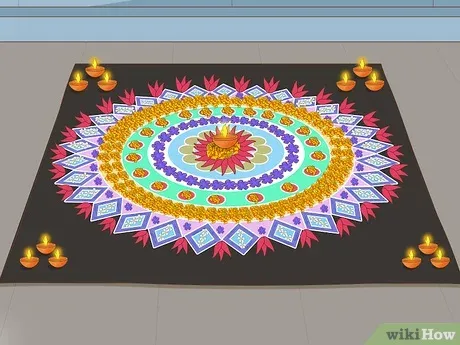Rangoli Art for Beginners: Tips to Get Started on Your First Design
Rangoli, a traditional Indian art form, is a colorful and intricate design often created on the floors of homes and public spaces during festivals and special occasions. This captivating art form uses vibrant colors, grains, and natural materials, symbolizing prosperity and welcoming guests. In this article, we will explore the essentials of Rangoli art, offering tips and techniques to help beginners successfully embark on their first design. We will also discuss various styles, tools, and materials, making it easier for you to create an impressive Rangoli that reflects your creativity and cultural heritage.
Understanding the Significance of Rangoli
Rangoli holds deep cultural and spiritual significance in Indian traditions. Often seen during festivals like Diwali, Pongal, and Onam, it is believed to invite prosperity, happiness, and good fortune into the home. The designs can vary from simple geometric patterns to complex floral motifs, each holding its own symbolism. For example, lotus patterns represent purity, while peacock designs signify grace and beauty. Understanding these meanings can help you choose designs that resonate with your intent and the occasion. Moreover, Rangoli is a collaborative art form, often created by families or communities, fostering togetherness and social bonds.
Materials Needed for Creating Rangoli
Before diving into your first Rangoli design, it’s important to gather the necessary materials. Traditional Rangoli is created using colored powders made from rice, flour, or chalk, but you can also use natural materials like flower petals, turmeric, and colored sand. For beginners, ready-made Rangoli powders are available in craft stores, making the process simpler. You will also need a flat surface to work on, ideally a clean and dry floor. To outline your design, you may require tools like a chalk piece, a pencil, or a thin stick. Additionally, a small sieve can help create finer patterns, while your creativity will be the most essential tool of all.
Choosing Your First Design
As a beginner, selecting an appropriate design is crucial for building confidence. Start with simple patterns like dots or basic geometric shapes. These foundational designs can later be expanded into more intricate creations as your skills improve. Popular beginner designs include flowers, mandalas, and simple motifs inspired by nature. You can use online resources, social media platforms, or art books to find inspiration. Remember to take your time and practice your chosen design on paper before moving to the floor. This approach will help you get a feel for the patterns and develop a better understanding of spacing and proportions.
Preparation: Creating a Clean Workspace
A clean and well-prepared workspace is vital for a successful Rangoli project. Begin by selecting a flat surface, free from dust and debris, ensuring that your design can be clearly seen. If possible, choose an area where your Rangoli will be displayed prominently, allowing others to admire your work. Once you’ve chosen your spot, use a broom to sweep away any dirt or particles, ensuring a smooth canvas. Some artists like to dampen the area slightly to help the powders stick better, but be cautious not to make it too wet. Having a dedicated space for your Rangoli can also help you focus on the creative process without distractions.
Creating Your Rangoli: Step-by-Step Guide
Once you’ve gathered your materials and prepared your workspace, it’s time to create your Rangoli. Start by sketching your design lightly with chalk or a pencil. This outline serves as a guide for placing your colored powders. Next, use your chosen colors to fill in the design, starting from the center and working your way outward. This method helps maintain balance and symmetry in your work. Be patient and take your time; rushing can lead to mistakes. If you’re using flower petals or natural materials, place them carefully to ensure they adhere to your intended pattern. Don’t be afraid to experiment with colors and textures to add depth to your design.
Tips for Enhancing Your Rangoli
To make your Rangoli even more eye-catching, consider adding embellishments and variations. Use contrasting colors to create depth, and try layering different materials for a mixed-media approach. You can also incorporate elements like diyas (oil lamps) or candles around your Rangoli to enhance its visual appeal, especially during evening celebrations. Additionally, experimenting with textures can bring your design to life; consider using rice, lentils, or dried flowers to create unique effects. Remember, Rangoli is not just about perfection—it’s about expressing your creativity and enjoying the process, so allow yourself to explore and have fun.
Cleaning Up and Maintaining Your Rangoli
After spending time creating your beautiful Rangoli, you might wonder about the maintenance and cleaning process. Ideally, Rangoli should be left intact to be admired for as long as possible, especially if it’s created for a special occasion. However, if it begins to fade or if the event comes to an end, you can gently sweep it away using a soft broom. Alternatively, you can photograph your Rangoli to preserve the memory of your art before cleaning it up. Remember to respect the materials you’ve used—if you’ve employed natural items like flower petals, consider composting them afterward to support environmental sustainability.
Conclusion: Embrace Your Creative Journey
Creating Rangoli is a rewarding and enriching experience that not only allows you to express your artistic abilities but also connects you to a rich cultural tradition. By understanding its significance, gathering the right materials, and following a step-by-step approach, you can craft a stunning design that reflects your personality and creativity. As you continue to practice and explore more intricate designs, you’ll find that Rangoli is not just about the final product; it’s a journey of self-expression and cultural appreciation. So gather your materials, unleash your creativity, and enjoy the beautiful art of Rangoli!
Keep an eye for more news & updates on Nextwe Blog!






